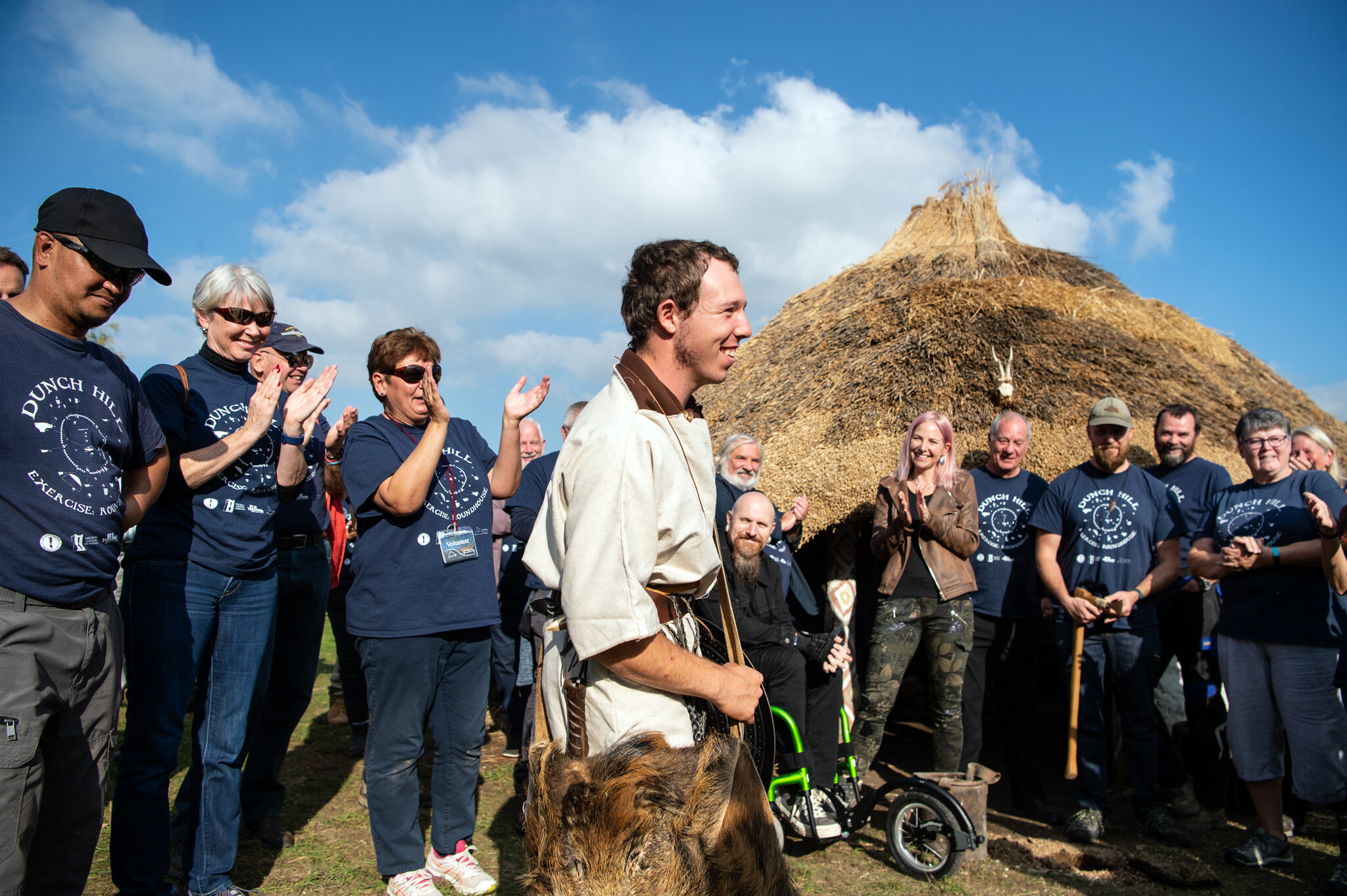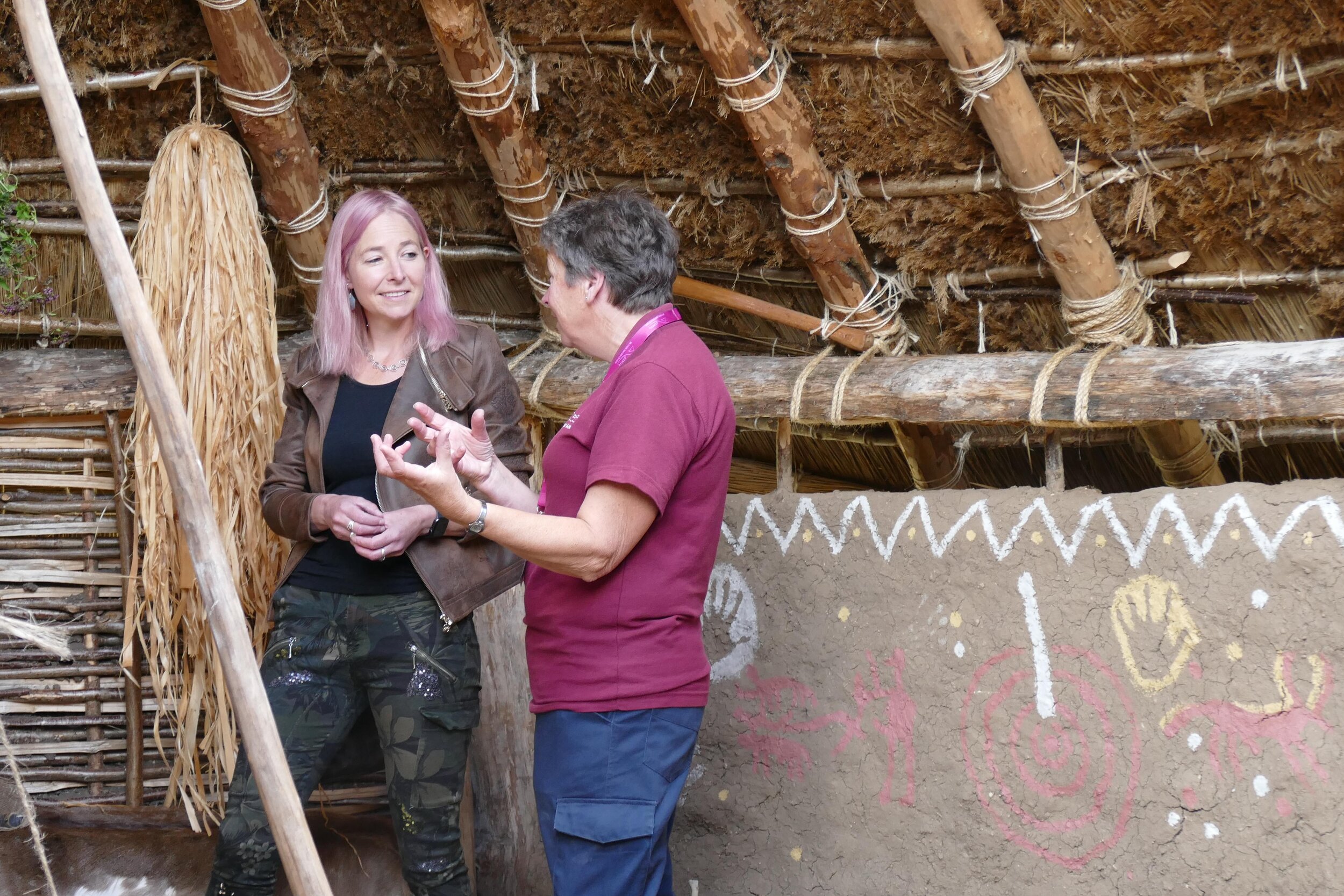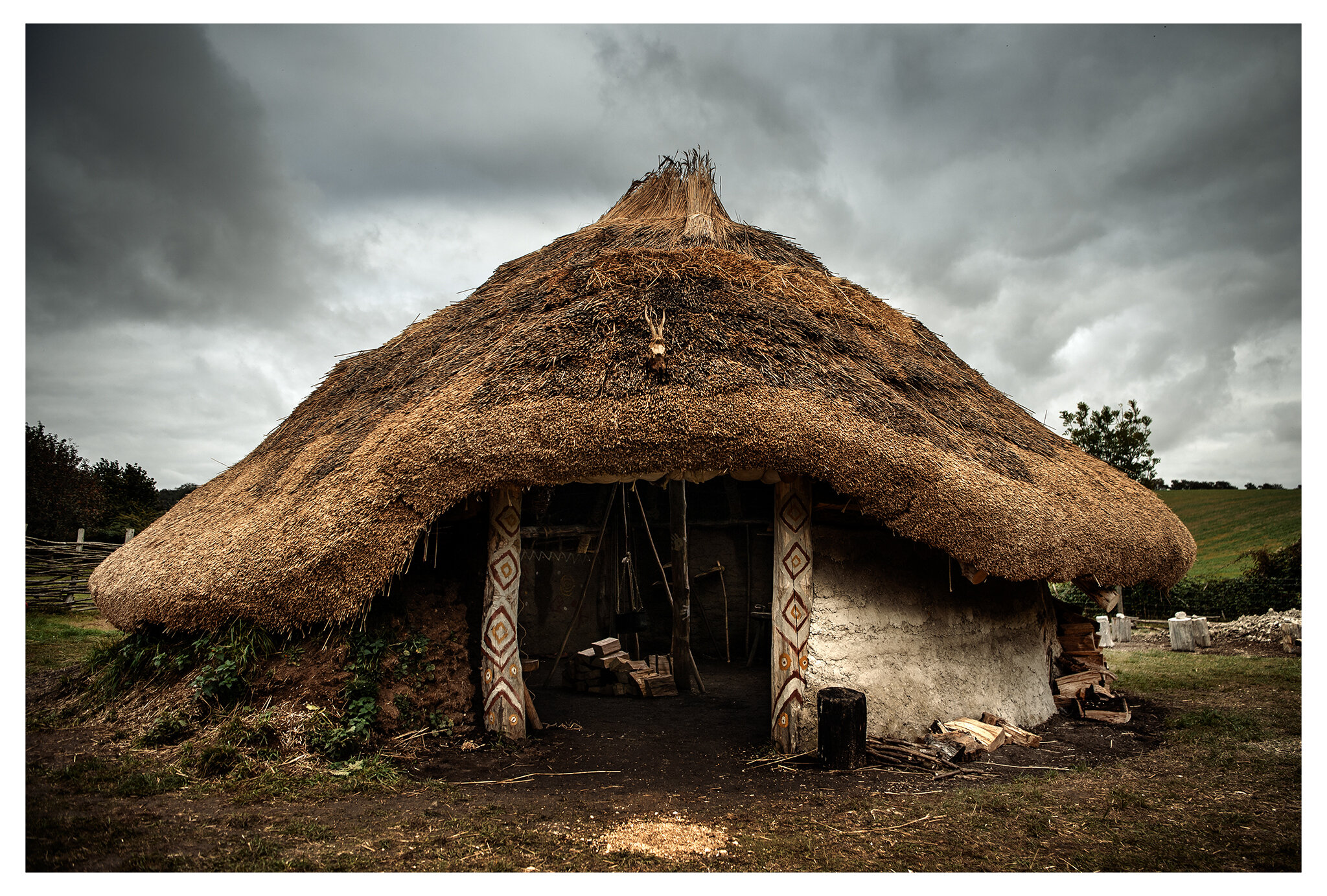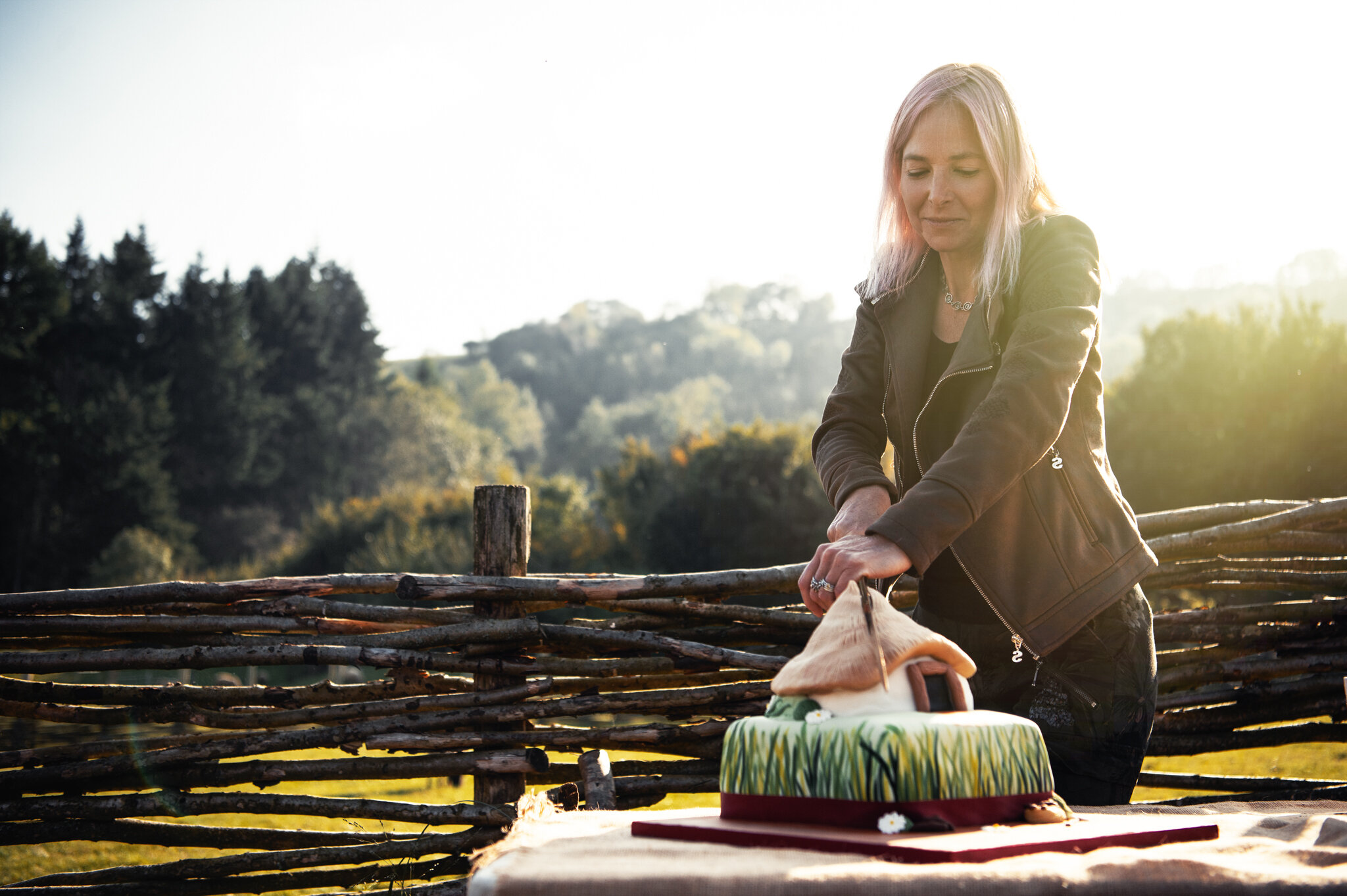
The Bronze Age Build Blog - reflections for the year!
In our last blog of 2021 Project Archaeologist Trevor reflects on our award-winning Bronze Age Roundhouse project! This project was recently honoured as a joint winner of the Council for British Archaeology’s Archaeological Achievement Award for Engagement and Participation, and as Trevor so poignantly describes here, the project has had a lasting impact on all those involved…
In our last blog of 2021 Project Archaeologist Trevor reflects on our award-winning Bronze Age Roundhouse project! This project was recently honoured as a joint winner of the Council for British Archaeology’s Archaeological Achievement Award for Engagement and Participation, and as Trevor so poignantly describes below the project has had a lasting impact on all those involved…
The Winter Solstice sun seen from the entrance to our Bronze Age Roundhouse
As 2021 draws to a close so does our Operation Nightingale Bronze Age roundhouse project. For a stationary object, it has launched an amazing array of journeys. I was chatting with Richard Osgood, one of the founders of Operation Nightingale, during one of our Butser Plus roundhouse chats a couple of weeks ago. We were marvelling about the fact that, in a little more than a year, our roundhouse had gone from a series of 3200 year old postholes to a finished building. Quite an amazing achievement! In the process I think that everyone involved has had their own personal journey – gaining new knowledge of the Bronze Age, new skills and, best of all, new friends.
Project Archaeologist Trevor
My own journey during this project has, when I think about it, involved so many unlikely twists and turns I sometimes think this project must have been destined to be. In a way, it started in 1916 when my grandfather enlisted in the Australian Infantry during WWI. As a child I spent a lot of time with him, and he was very much a role model. He was gravely injured on two occasions while performing his duty as a stretcher bearer on the Western Front. Although he never discussed his experience during the war, I know that his injuries had affected the rest of his life.
Almost 100 years after the First World War, and 50 years since my childhood memories were formed, my wife, Sue, and I were watching an episode of Time Team at home, in Australia. The episode featured an excavation by Operation Nightingale at a very significant Prehistoric and Anglo-Saxon site called Barrow Clump. What really moved me was Operation Nightingale’s mission to help rehabilitate veterans and service personnel through archaeology. I thought it was an absolutely brilliant initiative, but I wasn’t working in archaeology at the time, although it was something I was passionate about, and I was 12,000km away. Beyond the immediate enjoyment, I wasn’t expecting the programme to affect my life in any way. How little did I know.
Fast forward a few years and, a bit unexpectedly(!), I emigrated to England to a village that happens to be 5 miles from Butser. By some singularly unlikely twists of my career trajectory, I began working here, as it happened, almost precisely one century after my grandfather had enlisted. After a while I took over the volunteer co-ordinators role, job-sharing with Sue. As a not-for-profit Community Interest Company, part of our mission at Butser is to engage our community in ways that will benefit others as well as our site. That image of Time Team, Barrow Clump and Operation Nightingale had stayed tucked securely in my memory and now Sue and I found ourselves working in archaeology and creating and managing volunteer projects… you can see where I am going here.
The Excavation of the Dunch Hill Roundhouse (photo: Harvey Mills)
Good intentions sometimes stay that, and so it was with that dream of collaborating with Operation Nightingale. That was until, sometime around August last year, our colleague Phelim mentioned that Richard Osgood was on site. Poor fellow, he was innocently sketching, enjoying a quiet afternoon at Butser when I set upon him! It took about 5 minutes and the project was born. In short order I found myself looking at the remnants of a Bronze Age roundhouse on Salisbury Plain, not very far at all from Barrow Clump.
I can break this project down into some impressive statistics: 26 veterans and 8 civilian members of Operation Nightingale involved with the project, both on site building and creating and off-site, doing background research. 12 workshops were conducted for participants, involving Ancient Skills like bronze smelting and casting, pottery making, construction techniques, thatching, Bronze Age cooking, tool making, basketry, archery and sheep shearing! 266 volunteer days and 1144 volunteer hours were spent on the project, which saw our roundhouse go from zero to hero in 8 months. That’s even more impressive when you realise that, at the beginning, we were only working on it a couple of days every two weeks. And then there was our launch… most of the Operation Nightingale Team were able to attend, along with a lot of other people who had involvement with the project, including representatives from South Downs National Park, The Ministry of Defence and Step Together Volunteering who, between them, provided the funding that made it all possible.
And to celebrate, Butser was visited by some archaeological luminaries, each of whom gave up their time to come along – a great recognition of the Operation Nightingale initiative and of our project’s significance. Dr Rachel Pope, who is a roundhouse authority, made the journey from Liverpool, where she is Senior Lecturer in European Prehistory at the University of Liverpool. Dr Stuart Prior, who visited us earlier in the year while shooting for a forthcoming episode of Digging for Britain (keep an eye out for that…), came over from Bristol University where he is Reader in Archaeological Practice. Professor Alice Roberts officiated at the launch, while Phil Harding shared in our big day and told some cracking tales from his own long and illustrious career - it wasn’t lost on me that I was standing by two Time Team stalwarts, Phil having actually excavated with Richard at Barrow Clump! And if that wasn’t enough, the project was a joint winner of the Council for British Archaeology’s Archaeological Achievement Award for Engagement and Participation, announced only two weeks ago!
The Bronze Age build team with Stuart Prior, Alice Roberts and Phil Harding. (Photo: Harvey Mills)
But this project is much more than the finished roundhouse. Actually, that is just a by-product ( a wonderful by-product) of a fantastic wellbeing project from which, I think it is fair to say, all of us involved have benefited. Yes, it’s been quite the journey, but it was never intended to be the beginning and end of the bond between Operation Nightingale and Butser Ancient Farm, so watch this space. The journey continues.
The Winter Solstice sun behind our Bronze Age Roundhouse
The Bronze Age Blog - Session 16 - the thatch is complete!
Project Archaeologist Trevor gives an update on the latest progress with the Bronze Age house as the challenging job of thatching is completed!
Project Archaeologist Trevor gives an update on the latest with the Bronze Age house as the challenging job of thatching is completed!
We’re delighted to be able to report that our Operation Nightingale Bronze Age roundhouse is now all but finished. The crowning glory was the completion of the thatching of the roof this week. The entire team was involved in some way shape or form in the quite long and involved task of putting the conical roof onto our sturdy oak frame and then covering it with a few tons of water reed.
While it was very much a team effort, special shout-outs have to go to Darren Hammerton, treewright extraordinaire, and Lyle Morgans, Master Thatcher, who helped us get things started on the right foot. Also to John, one of our fantastic Operation Nightingale vet volunteers who took to thatching like a duck to water, and to Barnaby and Sarah, our two semi-resident archaeology students seconded from Bournemouth University for experience and slavery in the cause of experimental archaeology, who have also done sterling work in, on, and around the roof. And no-one will begrudge the biggest ‘for he’s a jolly good fellow’ being sung for Will, Butser’s own Man for all Seasons and all round great guy. Will has wrestled with what has turned out to be a very difficult, at times infuriating (expletives deleted) roof to build and thatch, and has come through scarred but unbeaten. Well done all!
Will Receives a well deserved round of applause at our Bronze Age celebration event (photo Harvey Mills)!
Why, I hear you ask, was the roof so difficult? Well, the main reason was the odd shape of the building. We call it a ‘roundhouse’, because it is an example of a type of structure favoured throughout the Bronze and Iron Ages (and beyond) in Britain and Ireland which were, more or less, round (in another striking example of the razor-sharp intellects native to all archaeologists, they are therefore called ‘roundhouses’). We also call it a roundhouse because it is a lot snappier than calling it an ‘irregular nonagon’, which is, in fact, what it is.
The thatching continued in all weather! Here’s student Barnaby on the roof.
So, what might this difficulty in building and thatching our irregular roof tell us archaeologically? The obvious answer is that the builders who built the original were dodgy. But, if you tip me upside down and pour cold tea down my nostrils, I will admit that I don’t think that’s the case. For one thing, there were other roundhouses found near ours that were impressively round and symmetrical – so they definitely knew how to craft a circular building (next time we’ll build one of these…). I am inclined to think there was a reason for the fact that some sides are longer than others (yes, sides, it’s a roundhouse with sides. Well, it’s an irregular nonagon with sides). We joked about making individual, custom length sides to accommodate particular pieces of furniture – a sideboard over there, next to the chaise longue on the long wall - that sort of thing. But jokes aside, why not? What I am even more convinced of, though is that – assuming our building did indeed have a roof (and that is always an assumption, as there is only fairly seldom direct evidence for them in prehistoric archaeology) – the Bronze Age builders built a roof in some way different from ours. So, if we DO ever build another irregular roundhouse (that’s a big if and I hope Will doesn’t read this too soon), then it’s a fair bet we will try a different experimental approach to putting a lid on it.
To follow more about our Bronze Age house project you can watch behind-the-scenes documentaries on our online platform Butser Plus whilst supporting our ongoing work.
The Bronze Age Build Blog - Operation Nightingale
In a special guest blog, Richard Osgood, Senior Archaeologist at Defence Infrastructure Organisation and co-founder of Operation Nightingale, reflects on the significance of the Bronze Age build project in the ongoing work of Operation Nightingale.
In a special guest blog, Richard Osgood, Senior Archaeologist at Defence Infrastructure Organisation and co-founder of Operation Nightingale, reflects on the significance of the Bronze Age build project in the ongoing work of Operation Nightingale.
Operation Nightingale began in 2011 with the mission of trying to improve the lives of Wounded/Injured and Sick (WIS) military personnel and veterans using archaeology. The results, which are measured, have been most encouraging and even for those who are simply looking for some respite from the daily pressures of life there are positive outcomes. The global trials of the Covid pandemic have only served to heighten the challenges for these participants with a particular emphasis on mental-health and wellbeing. And this is where the Bronze Age house has proved invaluable. We were fortunate enough to excavate the location of a roundhouse on Salisbury Plain in between lockdown regimes – outdoors and socially distanced – and this led to discussions with Trevor and Butser on the potential to try to reconstruct these findings at the Ancient Farm.
Thanks to so many partners such as South Downs National Park, the Armed Forces Covenant Fund, Breaking Ground Heritage and Step Together – this became a reality. In what always seemed to be sun-drenched days from spring to autumn the team stripped turf, dug holes, shaped timbers, painted murals, smelted copper, cast bronze, carved figures and much more; a job for everyone. In so doing they forged their own bonds and friendships – some are also now guides at the farm, or have gone to University to study archaeology. This has been the Op Nightingale project with greatest longevity and diversity of activities thus far – in perhaps the most trying times too. The feedback from participants has been outstanding and our task now will be to build upon this (wattle and daub or clunch!) framework to maintain the benefits. The project will need maintenance – a real positive – and will also provide hugely important academic data on these structures and the longevity of their experimental walls.
Photographs by Harvey Mills Photography
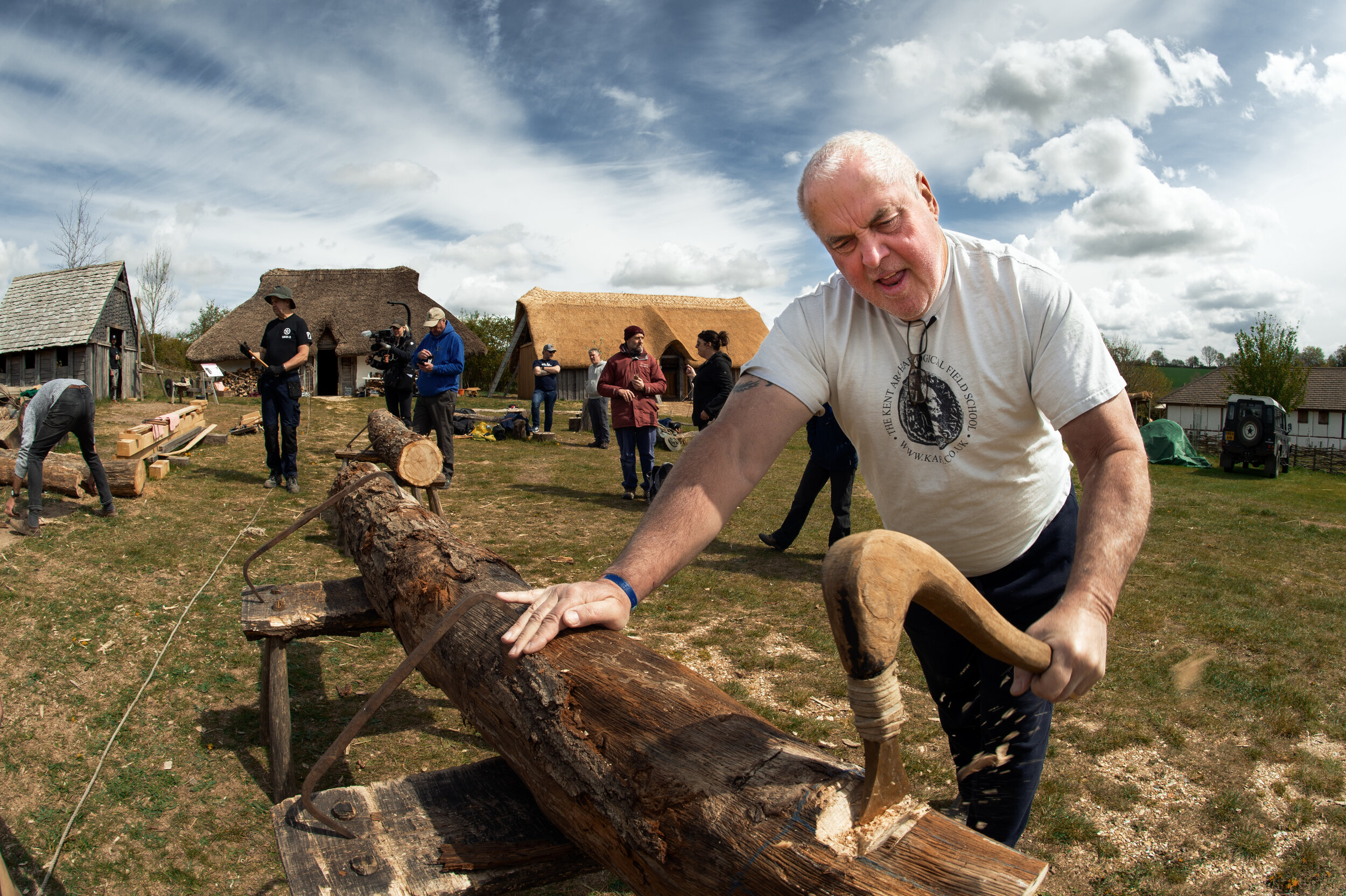
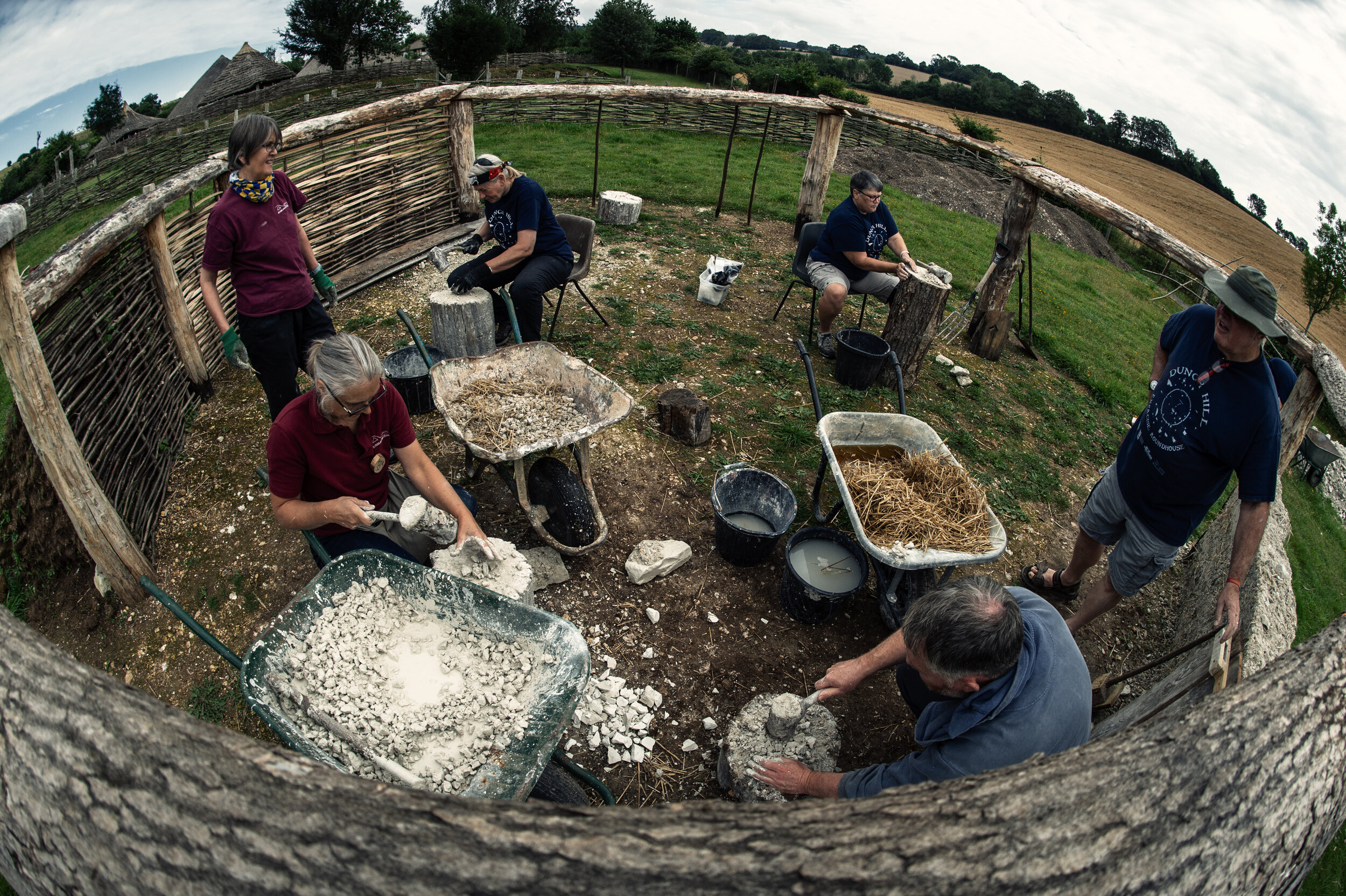
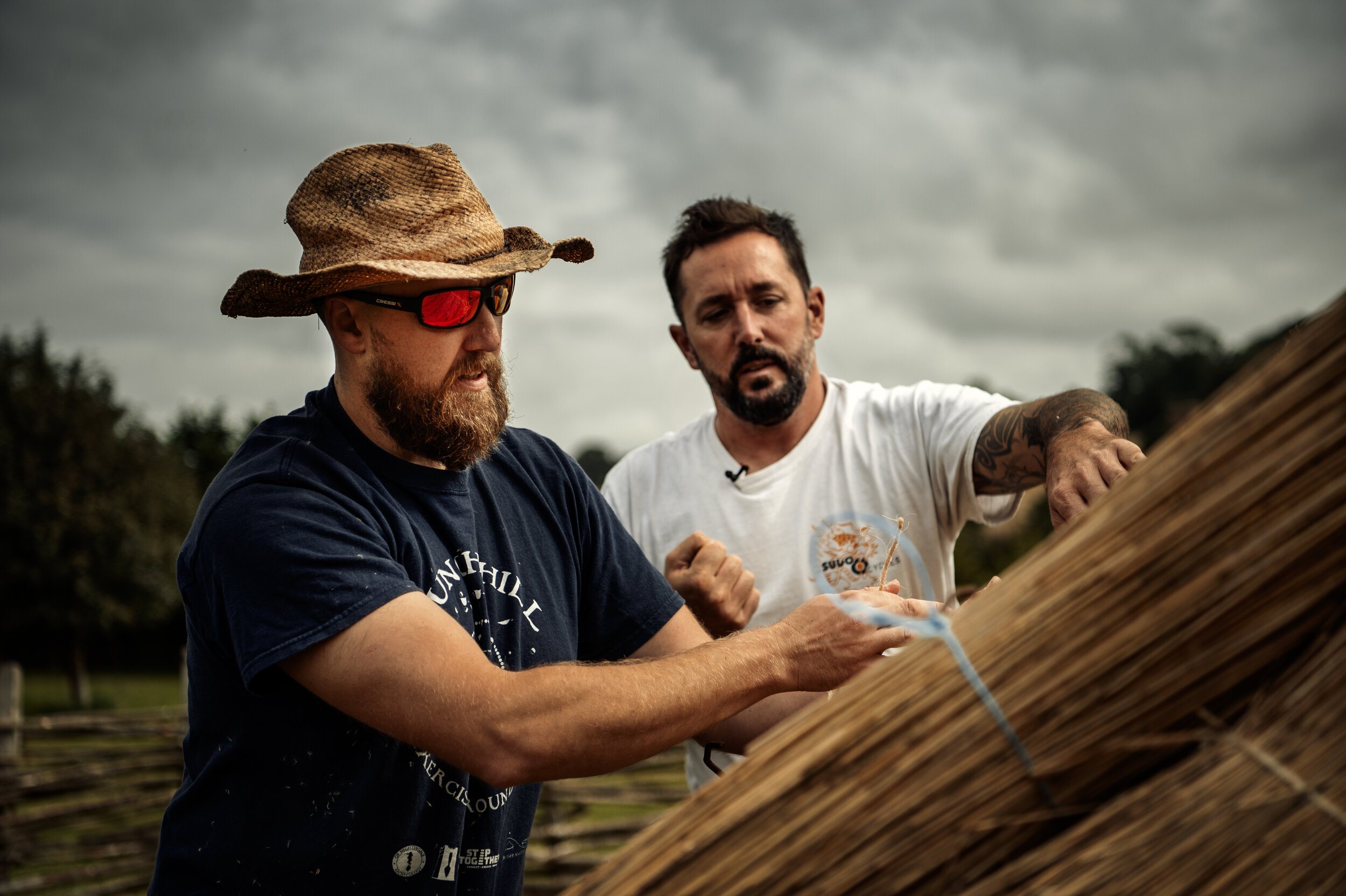
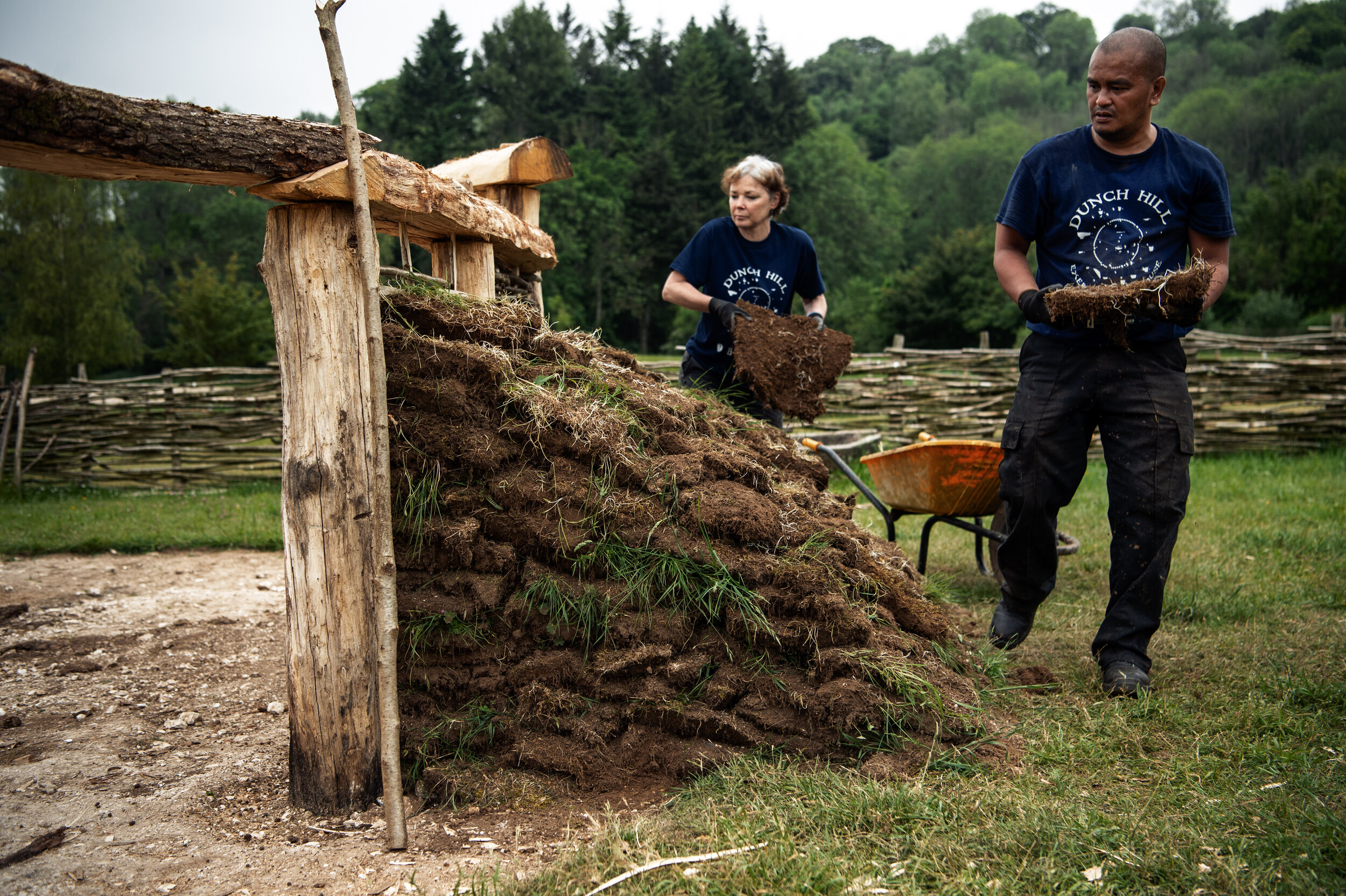
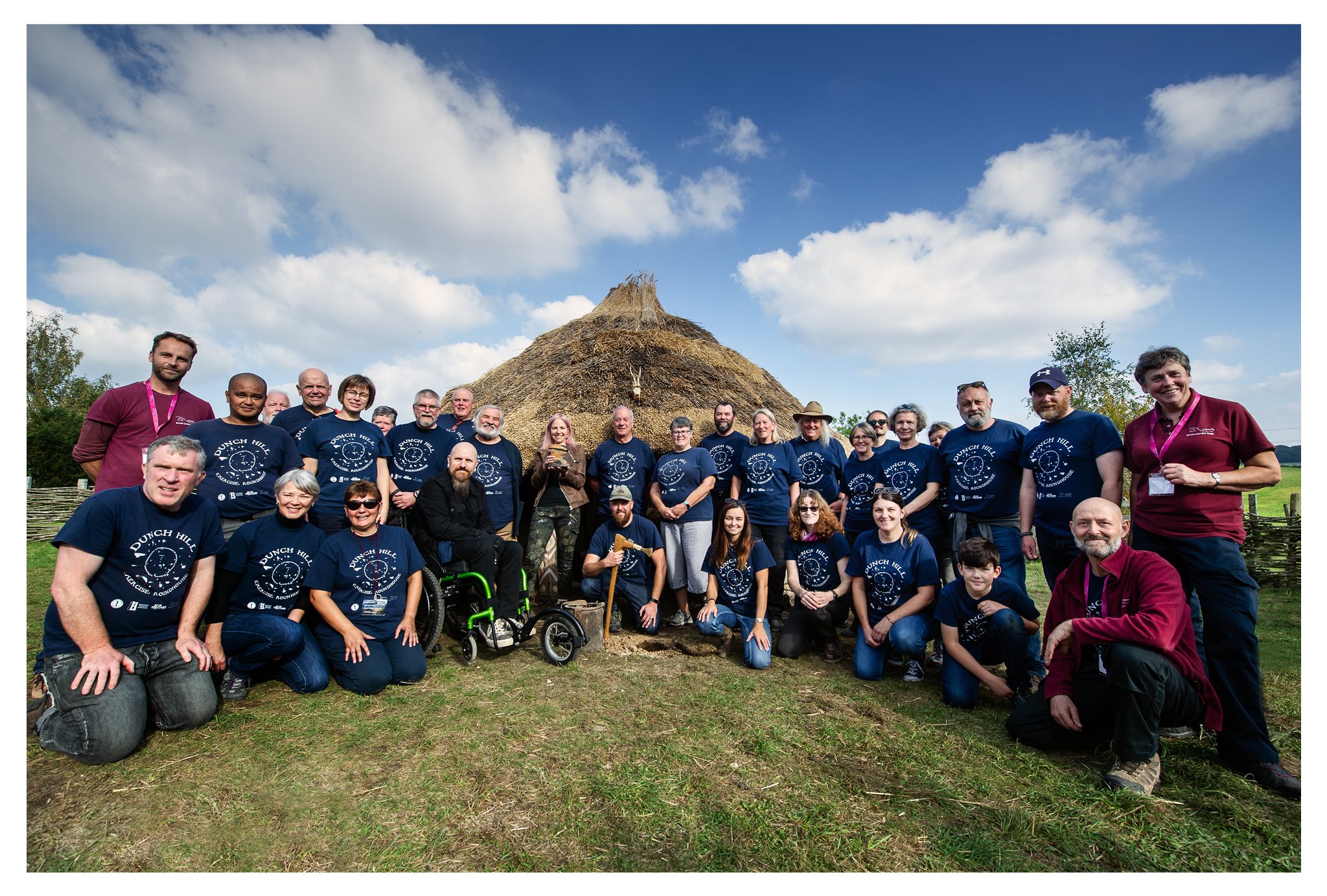
The Bronze Age Build Blog - Session 15 - the celebration!
Bronze Age project co-ordinator Trevor Creighton reflects on our celebration of the (almost!) completion of the Bronze Age roundhouse! We were joined by Professor Alice Roberts and Drs Phil Harding, Stuart Prior and Rachel Pope to celebrate this fantastic project!
Bronze Age project co-ordinator Trevor Creighton reflects on our celebration of the (almost!) completion of our Bronze Age roundhouse! We were joined by the volunteers, their families, local supporters and funders alongside Professor Alice Roberts and Drs Phil Harding, Stuart Prior and Rachel Pope to celebrate this fantastic project!
Saturday October 9th was the official launch day for the Operation Nightingale roundhouse and all of the stars turned out for the gala, red carpet (well, green grass) event. Although the building isn’t quite finished yet, we have been planning to hold an event at this time for some months. It seemed an ideal moment to celebrate the project while we still had a good chance of warm, dry weather – and we did, in spades! Rather than an official opening, we held a dedication ceremony to celebrate the achievements of the Operation Nightingale-Butser team. Professor Alice Roberts made the official dedication, ably assisted by Drs Phil Harding and Stuart Prior – all prominent archaeologists on and off the telly!
Left to Right: Dr Stuart Prior, Maureen Page - Director, Elaine Corner- Step Together Volunteering Manager, Simon Jay - Director, Professor Alice Roberts, Richard Osgood - Operation Nightingale, Dr Phil Harding, Trevor Creighton - Project Coordinator.
The Operation Nightingale Volunteer team
The roundhouse was looking stunning, made even more so by the decoration of interior walls and the two posts flanking the doorway. Our Creative Developer, Rachel, developed some creative schemes (see what I did there?) of figurative and abstract art inspired by Bronze Age pottery decorations and rock art, applied using pigmented clay wash. The icing on the cake was the completion of thatching the front of the building by our site manager and man for all seasons, Will, who has put an enormous amount of effort into the project from day one (and who, it must be said, rightfully received the biggest round of applause during the ceremony).
Director Maureen Page talks Professor Alice Roberts about the interior of the roundhouse.
The exterior of the Bronze Age roundhouse - this image clearly shows the diverse approaches to walling - turf on the left and clutch (chalk, hair, straw and water) on the right.
Site supervisor, thatcher, and Bronze Age interpreter Will receives a well deserved round of applause!
With our beautiful roundhouse as the backdrop, Richard and Elaine, from Operation Nightingale and Step Together Volunteering, respectively, joined Maureen and Simon to welcome everyone to the festivities, before Alice’s dedication words and the burial of a rather special pot. Quite often, prehistoric dwellings will have objects buried in or around them that seem to serve no practical purpose, but are too structured or peculiar to have been accidentally buried. The catch-all name for these finds is ‘deposition’. Although we don’t know what the meaning or purpose of such deposits was, the general consensus is that they are a dedication or offering for the home, either at the beginning or end of its useful life. In fact, this sort of practice wasn’t unique to prehistoric buildings, but has been practiced in Britain until very recently. Objects are found under or within medieval buildings, along with marks on timbers and walls, that are known to have been deposited or made to ward off evil and bring good luck. Indeed, it would be very surprising to think that the practice wasn’t still going on even in our contemporary, sceptical Western world.
The Operation Nightingale deposition consisted of objects placed in a simple pot, that had been made using Bronze Age techniques during the pottery workshop some months ago. Each of the Operation Nightingale team placed within it something that had some personal significance. In that way we were saying ‘we were here’ and perhaps that is a meaningful echo of those prehistoric deposits.
Operation Nightingale Volunteers and Alice Roberts with the pot ready for burial.
Operation Nightingale Volunteers and Dr Stuart Prior, Professor Alice Roberts and Project Coordinator Trevor Creighton.
Another special guest on the day was Dr Rachel Pope, Senior Lecturer in European Prehistory at the University of Liverpool, from where she had travelled to join us for the day! Rachel is an authority on roundhouse archaeology and construction and her enthusiasm for our project underscores its archaeological importance, which sits very nicely alongside of its significance as a truly unique wellbeing initiative and a piece of public archaeology for the education and enjoyment of what will be thousands of people in the coming years. I think it’s fair to say that this is unlikely to be the last such project.
The dedication was our opportunity to also thank the many people and organisations who have supported our project along the way. The cost of the materials used in the construction of the building was funded by a generous grant of £8,000 by the South Downs National Park Authority from their Covid-19 Recovery Fund, together with £35,000 for tools, materials and volunteer support which came from the Armed Forces Covenant Fund, thanks to a grant application compiled by Step Together volunteer charity. Step Together were also instrumental in recruiting, and providing assistance to, volunteers to work on the project. Without this funding the project would simply not have been possible.
Professor Alice Roberts cuts the Roundhouse cake with a Bronze sword!
We would like to warmly thank Alice, Phil, Stuart, and Rachel for making long treks from across the country to be with us and celebrate our project and, in doing so, help us to say a massive thankyou to the heroes of the piece – the Operation Nightingale volunteers/roundhouse builders.
Bronze Age re-enactors bring the Bronze Age house to life.
The whole Bronze Age building process has been documented on our online platform www.butserplus.com where you can watch step by step how we rebuilt the Bronze Age.
The Farm will be open to visitors during the whole of the October Half term week (23rd to 31st October) which will be the first opportunity to see our Bronze Age Roundhouse in person. We are also putting on a range of talks and Bronze Age themed activities to bring this special period to life at Butser. You can book tickets to visit us here
The Bronze Age Build Blog - Session 14
As we race to the finish line, Project coordinator Sue Webber reflects on how long it really takes to build a roundhouse.
As we race to the finish line, Project coordinator Sue Webber reflects on how long it really takes to build a roundhouse.
Visitors often ask, “How long does it take to build a roundhouse?” And that’s a hard question to answer because it depends. It depends on how many people are working on the house, what skills they have, what the weather is like and what unexpected challenges they face. But to try to answer that question, let’s say a team of six with some building skills, might take 30 days to complete a roundhouse like our Bronze Age house, using traditional methods. With more people, or more experience it could be quicker but with bad weather and poor materials it could take longer.
But that’s just the build time, behind the actual physical build there are years of preparation to supply the materials that are needed. It’s easy not to consider where the materials to build the house come from. In our society most building materials are available on demand in exchange for money. They don’t come direct from the forest or the field, they come from the builders’ yard or warehouse.
In prehistory, people needed to manage their own resources. If your community was spending time developing farmland and building houses they would also need to consider how to manage the other resources they would need. If you wanted a good supply of lightweight timber that could be used for fences and walls, you would need to develop some coppiced woodland close to your settlement. Moving materials over distance takes human, or animal, energy so it would be good to manage a woodland that wasn’t too far away. Put simply, if you cut down all the trees close to your community and turn the woods into fields, you will have a long way to walk every time you need wood.
Many types of trees can be coppiced. That’s a technique where young trees are cut back to a low stump which regenerates and new, straight trunks grow back. These stumps are called “stools”. Hazel is an excellent wood to coppice and if you explore the old woodlands in the south of England you can find large hazel stools that can be hundreds of years old. It takes about seven years for a coppiced hazel to grow a trunk that is long enough to be used for wattle fences or walls, so a hazel coppice would probably be cut every seven years. If you need hazel to build your house, which we did, someone would have had to have coppiced a local woodland seven years earlier to ensure the supply was ready when you needed it.
The other materials you need might have been growing for longer, like bigger tree trunks for the roof, or other materials that need to be grown and cut in season, in this case water reeds or wheat stems for the thatch. Perhaps these materials were cut in advance and stored somewhere ready for when they were needed. Perhaps they were traded with other communities.
Other materials could be readily sourced but would need preparation. To make daub for the wattle walls you would need to collect animal poo in advance to mix with soil and straw and water. Perhaps a group of people would dig a large pit to mix it in. Then, it might have been mixed like a traditional grape press by using the feet of the community to make the right consistency. If you wanted to make walls from crushed chalk, you’d need to dig another pit, crush the chalk and mix that too.
So how long does it take to build a Bronze Age house? If we count the time to grow, harvest and prepare the materials needed, it takes years.
To support our Bronze Age Roundhouse project with Operation Nightingale and discover more behind the scenes footage of the build head to at www.butserplus.com where we are releasing weekly video episodes about work and projects at the farm. Thank you!
The Bronze Age Build Blog - Session 13
Project Coordinator Trevor Creighton updates us with the latest progress on the Bronze Age house build , and reflects on the community that has been built along the way, as we race towards the finish line!
Project Coordinator Trevor Creighton updates us with the latest progress on the Bronze Age house build , and reflects on the community that has been built along the way, as we race towards the finish line!
Our recent build days were September 22nd, 23rd and 24th. The planned completion is early October. Need I say more about what we were doing? Everything, which, in my case, includes a mild dose of panic.
It really was an all hands to the pump three days – fixing battens high on the roof, while below their already fastened companions were having thatch fixed to them in a race to the top. All the variations of technique in our tasting menu of walls were in play – soil mounds, wattling, daubing, finishing a gabion and cob walling were all happening, with the team moving at a blistering pace. Workers moved by at such speed that they registered on my retina as mere blurs, putting me in mind of the Tasmanian Devil from Looney Tunes Cartoons (both of these phenomena serving to highlight my age).
None of this is to suggest that there is any chaos on the building site (except in my febrile mind). Far from it, in fact. Everyone who is involved has acquired and honed a range of new skills. Some people even like to specialise, while others are eager for a new challenge. So the building is now in the hands of craftspeople who are keen to turn up and get on with things, drawing upon their own experience. Frankly, I love it – I get to sit around and talk, point at things and drink tea. I can't speak for Phelim and Sue, of course. I expect they are nose to the grindstone. It's a good thing that the building is near completion. By the time anyone reads this it will almost be too late for me to appear before any disciplinary tribunal, get the sack or be shouted at.
Actually, there is every reason to think that this is the sort of organisational model that the original builders of our roundhouse would have been familiar with. While we know that there were highly skilled craft specialists in the Bronze Age. Metallurgists, bronzesmiths and jewellers are evidenced by the surviving metalwork, but it is surely the case that there were many other areas of specialisation whose makers worked with less durable materials. At a small settlement like Dunch Hill, however, I think that, if we had a TARDIS, we would see a small community or extended family pitching in with greater or lesser areas of expertise and to the best of their abilities. Some will have seen or participated in building other structures and most would almost certainly be familiar with repairing these relatively fragile buildings. And, yes, in this time travelling of my mind's eye I even see a version of me, lying around in the sun and avoiding work at all times. It is even possible that they were a distant ancestor – perhaps laziness is an inherited trait – surely a worthy study for anyone interested in DNA analysis?
Actually, I would say that we have actually gone beyond just being a 'team' and formed something approaching a community. We share a single objective of completing a roundhouse – a satisfying goal in itself. But no-one secretes themselves away at lunch time, desperate to escape. In fact, we are often visited by other Butser staff who are keen to share in the lunchtime banter. That is a hard thing to test – when does a team become a community? But it is something I think I have felt before, on our recently completed Horton 2 Neolithic building. Whatever you want to call it, it's a great thing and long may it last. Now that we have such a great little group I hope that we can go on to do more projects. All we need do now is give people some tools and materials, point them at a bare patch of earth, give a rough description of what we need built and the job is a good as done. As it happens, we need a new Iron Age roundhouse, as one of our old faithfuls had to be demolished recently. It had succumbed to the ravages of woodworm and age. That, by the way, is not a 'fault' with the building, but an experimental result – it provides us with important data about the lifespan of buildings, which is one of the most important reasons we build them. In fact, the most valuable data often comes from a building's demolition!
So for our next building we already have the construction crew, we just need the resources. And on that note, resource management was something that was vital in prehistory, just as it is now. The Bronze Age wasn't a time of foraging for what you could get, but managing the world around you to ensure you could get what you need. That is a great jumping off point for the next blog!
To support our Bronze Age Roundhouse project with Operation Nightingale and discover more behind the scenes footage of the build head to at www.butserplus.com where we are releasing weekly video episodes about work and projects at the farm. Thank you!
The Bronze Age Build Blog - Session 12
Project Coordinator Sue Webber gives the latest update on the Bronze Age roundhouse project as the volunteers get stuck in to the very satisfying job of daubing!
Project Coordinator Sue Webber gives the latest update on the Bronze Age roundhouse project as the volunteers get stuck in to the very satisfying job of daubing!
Daub therapy
While the thatching progresses, we also continue to work on the walls beneath. Daub is the material that goes on to wattle to make wind-proof roundhouse walls. It’s the school children’s favourite recipe of mud, water, straw and animal poo! Once mixed together it makes a sticky substance that can be smeared over wattled walls and into twiggy cracks and cavities.
Daub needs protection from the rain if it is to dry, so we needed to wait for the thatching to start before we could daub the walls under the thatch. We’re not daubing all the walls in this house because we are testing a variety of wall types and materials.
Our daubers soon discovered the delights of smearing daub on wattle walls. They enjoyed the work so much that it became a slow, social process that we named “daub therapy”. You can sit and talk while you daub and you gradually watch while your work covers the wall, giving a sense of achievement and satisfaction. It’s hands-on work at a human pace that probably felt the same 3000 years ago when the Bronze Age builders were working.
Our experimental walling choices have already started to give us results about what works, and what doesn’t. We built some lightweight wattle walls and banked turf against one and loose soil against another two. The turf wall is consolidating well with a good variety of plants growing there already. The smaller soil-banked wall is doing fine but its wider brother started to bow inwards from the pressure of the soil banked up against it.
We can see that this would soon be a problem with the weight of the soil forcing the wattle inwards, so we decided to remove the soil, release the pressure and see what we could do to re-consolidate the wattle. Once the pressure was off the wattle, we were able to straighten it up and support it with some extra uprights that slotted into holes in the lintel above the wall and into holes in the ground that we then packed with flint chips and earth. This has made a great improvement and the wall will now support the weight of the soil banked up against it once more. Just to be safe we have also added two more large uprights at either end of the wattle wall to lock it in place. While we have now strayed a little from the archaeology on this wall section, we have learnt some valuable lessons.
Lightweight wattle walls won’t support a soil bank if they are wide and if they are not firmly anchored. Because we followed the original excavation on the positions of the post holes we couldn’t make the distance between the posts narrower. So, this means that either this wasn’t a banked soil against wattle wall, or if it was, the wattle would need to be securely anchored to support the weight of the soil.
As our work continues, we’ll get more information on which of our experimental wall-types work and which aren’t so successful. It’s only by building these different walls that we can get a real understanding of the options available to Bronze Age builders.
The Bronze Age Build Blog - Session 11
Archaeology co-ordinator Trevor gives an update on the Bronze Age build as we begin the major job of thatching our roundhouse! Thanks to Harvey Mills for the great photos of the start of the thatching!
Archaeology co-ordinator Trevor gives an update on the Bronze Age build as we begin the major job of thatching our roundhouse! Thanks to Harvey Mills for the great photos of the start of the thatching!
The first day of September was also the first day of thatching on our roundhouse. From here on our structure starts to look like a house. Lyle Morgans, the master Thatcher who has done such fantastic work on many of our buildings, and the subject of recent Butser Plus videos, spent the day introducing our team to the time-honoured craft.
Our roundhouse will be thatched with water reed. It’s a very durable material and one that might well have been available to the Bronze Age residents of Dunch Hill. The river Avon flows quite near the site of the original building and, although there are no reed beds there now, it is very possible that it was a source of reed in prehistory, when both climate and water use were different to the present day.
There is ample evidence in the archaeology of Bronze Age Britain for the use of thatch. Today the most common thatching materials in Southern Britain are long straw or water reed, like ours. However, other materials are suitable for thatching, such as heather and gorse. It is most likely that people used the most readily available resources, which may have seen them use a mixture of materials to cover a single roof.
There are different techniques which can be used to thatch. Our water reed will be tied to horizontal hazel battens that are fixed to the roof rafters at close intervals, from top to bottom. Lyle demonstrated the technique of tying regular bundles of reed – called ‘yelms’ – to the battens. They are secured to the battens and to each other with twine so that they form a continuous, tightly packed band around the entire perimeter of the building. The first row looks a bit like a fringe. As the thatch is tied higher up the roof, the higher yelms overlap those below them, covering the twine that secures the lower thatch to ensure that the roof is waterproof and to minimise the chance of the twine rotting and breaking.
In a final flourish, the thatch is dressed into neat, even rows as it is tied on using a tool called a leggett. By the end of the day we had not only learned the basics of the magic of thatching but also some arcane terms – so it was a little like joining the secret society of thatchers! All of we Magician’s Apprentices learned a lot and had another great day. A couple of the team have taken to thatching like ducks to water. John, in particular, is looking like becoming competition for Lyle in the not too distant future, although I think the allure of archaeology will prove too strong.
With all of this new found expertise and enthusiasm, combined with the experienced guiding hand of Butser’s own Man for All Seasons, Will, we aim to have the thatching finished by early October. Fingers crossed and yelms at the ready.
To support our Bronze Age Roundhouse project with Operation Nightingale and discover more behind the scenes footage of the build head to at www.butserplus.com where we are releasing weekly video episodes about work and projects at the farm. Thank you!
Blog archive
- November 2025 2
- September 2025 1
- April 2025 2
- February 2025 1
- January 2025 1
- November 2024 2
- August 2024 1
- July 2024 2
- May 2024 1
- November 2023 1
- October 2023 1
- September 2023 1
- August 2023 1
- July 2023 1
- June 2023 2
- May 2023 2
- March 2023 1
- February 2023 1
- December 2022 1
- October 2022 1
- August 2022 2
- April 2022 1
- March 2022 2
- February 2022 1
- January 2022 1
- December 2021 2
- November 2021 3
- October 2021 2
- September 2021 5
- August 2021 2
- July 2021 3
- June 2021 3
- May 2021 2
- April 2021 4
- March 2021 1
- November 2020 1
- October 2020 2
- August 2020 1
- March 2020 4
- February 2020 4
- January 2020 3
- December 2019 3
- November 2019 1
- October 2019 1
- September 2019 1
- August 2019 1
- July 2019 6
- June 2019 3
- April 2019 2
- March 2019 3
- February 2019 2
- January 2019 1
- November 2018 1
- October 2018 2
- September 2018 3
- August 2018 4
- July 2018 2
- June 2018 2
- May 2018 2
- March 2018 6
- February 2018 1
- October 2017 1
- September 2017 5
- August 2017 4
- July 2017 3
- June 2017 1
- May 2017 1
- April 2017 3
- March 2017 2
- February 2017 3
- January 2017 1
- December 2016 2
- November 2016 1
- September 2016 1
- August 2016 2
- July 2016 2
- June 2016 3
- May 2016 2
- April 2016 1
- March 2016 2
- February 2016 1
- January 2016 3
- December 2015 2
- November 2015 1
- October 2015 1
- September 2015 2
- August 2015 1
- July 2015 2
- June 2015 2
- May 2015 3
